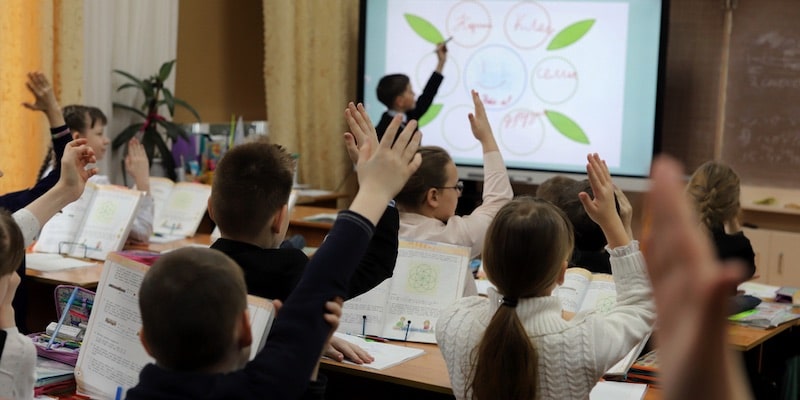We explain what meaningful learning is, what its characteristics are and what types exist. Also, its advantages and the role of the teacher.

What is meaningful learning?
Meaningful learning It is a process in which students acquire new knowledge by relating it to previous knowledge and experiences This means that when a student learns information, it is associated with what he already has and, as a result, both change: new information is added and old information is restructured.
From this perspective, the incorporation of knowledge must be substantial and not arbitrary meaning that it must be done in a well-founded and comprehensive manner rather than by rote. In this way, an interaction occurs between what is being learned and pre-existing ideas. This is what allows new content to take on meaning. Learning not only involves adding information to memory, but also producing a cognitive change.
Frequently asked questions
What is meaningful learning?
Meaningful learning is a process in which new information is acquired by relating it to previous knowledge, allowing for logical and lasting understanding.
What are the main characteristics of meaningful learning?
The main characteristics of meaningful learning are the connection of new knowledge with previous knowledge, the coherent organization of learning content and the active participation of the student.
What are the advantages of meaningful learning?
Meaningful learning allows for the acquisition and storage of a greater amount of information, and a better understanding and retention of knowledge. In addition, it encourages autonomous learning, which is motivating for students.
What are the implementation phases of meaningful learning?
The implementation phases of meaningful learning are the preparation or activation of prior knowledge, the presentation of new content and the application of what has been learned to specific situations.
Origin of the theory of meaningful learning
The theory of meaningful learning It was proposed by the American psychologist and pedagogue David Ausubel (1918-2008) whose work was extremely important in the development of pedagogical constructivism. His theories opposed from the beginning the traditional model of education by repetition and memorization, which assigns the student a passive role in relation to the educational event.
According to Ausubel's theories, Meaningful learning is permanent, produces a change in patterns of cognition and is based on previous experience. Furthermore, it can occur both with the participation of the teacher as a guide and advisor of the learning experience, and in a self-taught way, through the student's own discovery.
Characteristics of meaningful learning
The main characteristics of meaningful learning are:
- Connection with prior knowledge. The new information must be related to what the student already has.
- Organization of contents. The learning material must be logical and coherent.
- Motivation. The teacher must stimulate interest and willingness to learn, through the selection of relevant content that students can relate to their experiences.
- Active participation. The student has an active role in the learning process, through reflection and analysis.
- Teaching organization. Didactic tools are used to collaborate with the structuring of new knowledge. For example, concept maps, questions, reflection and synthesis exercises.
- Long-term memory. Meaningful learning lasts over time and can be applied in different contexts.
Types of meaningful learning and examples
David Ausubel distinguishes three types of meaningful learning:
Representation learning
Representation learning is the fundamental form of meaningful learning. It involves giving meaning to symbols that is, associate them with what they represent.
For example, a child learns the word “dog” by relating it to his own dog. He does not yet understand the concept of the word (which includes all dogs), but only has a representation of it (a particular dog).
Concept learning
Concept learning happens when regularities are perceived in events or objects, and the symbol no longer depends on a specific referent. Involves the acquisition of categories.
For example, when the child observes common characteristics associated with the word “dog,” that symbol begins to represent all animals that share certain attributes.
Proposition learning
Proposition learning is about give meaning to new ideas through a proposition or statement relate concepts and express judgments about them. It allows establishing logical relationships and more structured and complex knowledge.
For example, if the child is told that dogs are mammals, he or she can establish that his or her own dog is a mammal.
Continue with: Logical thinking
Advantages of meaningful learning
Meaningful learning provides multiple advantages for educational processes. It allows you to acquire and store a large amount of ideas and information effectively,by relating potentially significant content with prior knowledge.
This approach gives the student a leading role, which motivates, stimulates and promotes interest in learning. The knowledge acquired with this method tends to be more permanent than memorized knowledge, because it is related to real experience and concepts already incorporated.
Furthermore, it promotes an educational model that provides greater autonomy reinforces self-esteem and allows each individual to learn in a personalized way according to their own mental structures and previous experiences.
The role of the teacher in meaningful learning
The role of the teacher in meaningful learning It is similar to that of a facilitator or companion of the process, who must mediate between knowledge and students. It is about guiding and guiding activities, unlike the traditional role of the teacher in the repetition learning model, which considers it a vehicle for transmitting information.
According to the vision of David Ausubel, the role of the teacher is determined by six fundamental tasks:
- Identify the most relevant concepts, propositions and ideas of the content to be learned.
- Identify what concepts, propositions and ideas students should have in order to address the content to be learned.
- Carry out a diagnosis to find out if students handle the content necessary to assimilate the new topic.
- Help each student to assimilate the content according to their own cognitive structure.
- Promote direct contact between students and knowledge, and provide the necessary guidance to solve problems that arise.
- Lead students towards putting the acquired knowledge into practice, so that it can be assimilated and endure.
How to implement meaningful learning in the classroom?
To apply the principles of meaningful learning in the academic environment, it is recommended to understand the classroom experience as a succession of phases or stages:
- Preparation. An initial challenge is posed, that is, an obstacle, an activity or a debate, which serves as a trigger to explore the knowledge that students already have about the topic to be learned. Students have an active role, because they explore their memory in a practical and autonomous way.
- Presentation New information is introduced, in a clear and organized way. Different types of resources are used, which can be images, videos, information extracted from magazines or books, among others. The objective of this stage is to connect the new data with the previous ones.
- Application. New concepts must be applied in exercises and practical situations. This stage helps students reinforce and integrate what they have learned. Finally, the skills acquired are evaluated through the approach of new situations, projects or group discussions.
document.addEventListener(“DOMContentLoaded”, (e) => {
var sliderContainer, slider;
sliderContainer = document.getElementById(‘block_93df0595d667055c0224bee82eb956bf’);
if (typeof initSlider !== ‘function’) {
console.log(‘Swiper haven\’t been loaded’);
sliderContainer.className += ‘ fw scroll-snap’;
return;
};
options = {
direction: ‘horizontal’,
speed: 1000,
slidesPerView: ‘auto’,
// slidesPerGroup: 1,
centerInsufficientSlides: true,
// centeredSlides:true,
spaceBetween: 15,
breakpoints: {
720: {
// centeredSlides: false,
// slidesPerGroup: 2,
spaceBetween: 25
},
},
pagination: {
el: ‘.swiper-pagination’,
type: ‘bullets’,
clickable: true
},
}
slider = initSlider(sliderContainer, options);
})
References
- Ausubel, D. (1978). Educational psychology. A cognitive point of view. Thresholds.
- Moreira, MA (sf). Meaningful learning: an underlying concept. UFRGS Physics Institute. http://www.if.ufrgs.br





